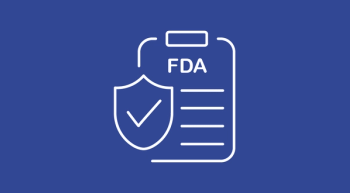
Rina-S Given Breakthrough Therapy Designation in Endometrial Cancer
The investigational ADC rinatabart sesutecan was given breakthrough therapy designation for use in patients with recurrent/progressive endometrial cancer.
The FDA has issued breakthrough therapy designation to the antibody-drug conjugate (ADC) rinatabart sesutecan (Rina-S; GEN1184) for use in patients with recurrent or progressive endometrial cancer whose disease progressed on or after treatment with a platinum regimen in addition to a PD-1 or PD-L1 therapy, as shared in an announcement from the drug’s developer, Genmab.1
This regulatory decision is supported by data from the phase 1/2 RAINFOL-01 trial (NCT05579366) presented at the
Investigators shared data from RAINFOL-01’s monotherapy dose-expansion B2 cohort, which assessed the safety and efficacy of the investigational folate receptor alpha (FRα)-directed TOPO1 inhibitor.
“For our patients who have differing levels of FRα expression, there’s a real need to try to expand [the use of] FRα-targeted therapies to more of our patients with ovarian cancer,” said investigator Elixabeth K. Lee, MD, in an interview with Oncology Nursing News’ sister brand OncLive. Lee is a medical oncologist in the gynecologic oncology program at Dana-Farber Cancer Institute and an instructor in medicine at Harvard Medical School in Boston, Massachusetts.
What data on Rina-S were presented at ASCO?
Data from RAINFOL-01, then called GCT1184-01, presented at the conference revealed that as of the data cutoff of November 22, 2024, 64 patients with heavily pretreated endometrial cancer received 100 mg/m2 (n = 22) or 120 mg/m2 (n = 42) of Rina-S for a median of 15.9 weeks.2
The primary end points of the investigation were safety and tolerability of the drug, with secondary end points of objective response rate (ORR) and duration of response (DOR).
Serious treatment-emergent adverse events (TEAEs) occurred in 37.5% of patients. The most common TEAEs, occurring in over 25% of patients, were largely cytopenias and grade 1 to 2 gastrointestinal issues, such as nausea, vomiting, and decreased appetite. Grade 3 to 4 cytopenias occurred, including neutropenia (48.4%), anemia (35.9%), and thrombocytopenia (21.9%).
TEAEs led to Rina-S dose reductions in 15.6% of patients and discontinuation in 3.1% of patients. At 120 mg/m2, 1 related grade 5 TEAE confounded by comorbidities occurred, as assessed by the investigator. Signs of ocular toxicity, neuropathy, or interstitial lung disease (ILD) were not observed.
“We predominantly saw grade 1 or 2 cytopenia and gastrointestinal [toxicities]. Notably, 45% of patients did experience grade 3 or 4 anemia and neutropenia at the 120 mg/m2 dose level, but this was well managed with granulocyte-colony stimulating factor, which was allowed to be used reactively,” said Lee. “This occurred in 55% of patients at the 120 mg/m2 dose level. Overall, this is a fairly well tolerated agent.”
Patients had received a median of 3 prior lines of therapy (range, 1-8) and 48.4% had received previous radiotherapy. Most patients had an ECOG status of 1 (64.1), and 46.9% were age 70 or older. The most common disease type was endometrioid carcinoma (45.3%), followed by serous carcinoma (26.6%).
In patients for whom efficacy was evaluable, the median follow-up was 18.7 weeks. For patients on the 100 mg/m2 dose (n = 22), the unconfirmed ORR was 50%, with 2 complete responses. Likewise, the unconfirmed ORR was 45.5% for patients on the 120 mg/m2 dose.
Additionally, the disease control rates (DCR) were 100% and 81.8% in the 100 mg/m2 and 120 mg/m2 dose groups, respectively. Responses continued for 9 out of 11 patients (81.8%) of patients receiving 100 mg/m2 and 12 out of 15 patients (80.0%) patients receiving 120 mg/m2.
How is Rina-S being investigated currently?
In RAINFOL-01, Rina-S is being investigated in multiple parts: Part A, dose escalation; Part B, tumor-specific monotherapy dose-expansion cohorts; Part C, platinum-resistant ovarian cancer cohort; Part D, combination therapy cohorts; Part F, monotherapy endometrial cancer cohort; and Part K, monotherapy QTc cohort in high-grade ovarian cancer.
Rina-S is also being investigated in platinum-resistant ovarian cancer in the open-label, randomized phase 3 RAINFOL-02 trial (NCT06619236).3 Patients enrolled in RAINFOL-02 will be assigned 1:1 to receive either Rina-S or investigator’s choice of chemotherapy.
Patients must have received prior platinum chemotherapy, bevacizumab (Avastin; unless contraindications exist), along with a PARP inhibitor or mirvetuximab soravtansine (Elahere) for certain patients.
Approved chemotherapies patients may receive include paclitaxel, topotecan, pegylated liposomal doxorubicin, and gemcitabine. The primary end point is progression-free survival (PFS), and secondary end points include overall survival (OS), objective response rate (ORR), duration of response (DOR).
References
- Genmab receives FDA breakthrough therapy designation for rinatabart sesutecan (Rina-S®) in advanced endometrial cancer (EC). Genmab. News release. https://ir.genmab.com/news-releases/news-release-details/genmab-receives-fda-breakthrough-therapy-designation-rinatabart
- Rinatabart sesutecan (Rina-S) for patients with advanced endometrial cancer: First disclosure from dose expansion cohort B2 of the GTC1184-01 study. JCO 43, 3039-3039(2025). doi:10.1200/JCO.2025.43.16_suppl.3039
- Study to asses the efficacy of Rina-S compared to threatment of investigator’s choice in participants with platinum resistant ovarian cancer (RAINFOL-02). ClinicalTrials.gov. https://clinicaltrials.gov/study/NCT06619236
Newsletter
Knowledge is power. Don’t miss the most recent breakthroughs in cancer care.

















































































